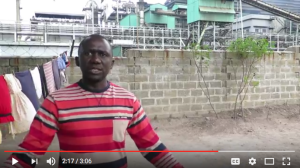
July 20th 2016. In October 2015 Foil Vedanta visited Vedanta’s Zambian subsidiary Konkola Copper Mines (KCM) for the second time to investigate the legacy of pollution that has destroyed the environment and livelihoods around Chingola since 2004, when Vedanta bought controlling shares in KCM. KCM is Africa’s largest copper mine and the largest mining company in the copper dependent economy of Zambia. Our 2014 report Copper Colonialism: Vedanta KCM and the copper loot of Zambia exposed some of KCM’s major corporate malpractices including large scale tax evasion and mis-declaring profits, labour rights violations, and gross pollution which has continually contaminated the river Kafue causing sickness and loss of livelihood for tens of thousands of Zambians. We accused Vedanta and the UK government, which has given KCM active and tacit support, of neo-colonialism and of treating Zambian lives and environment as cheap.
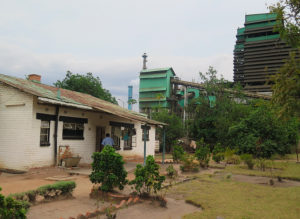
We were particularly shocked when we visited KCM’s Nchanga smelter in the heart of Chingola town, to see communities living less than 50m away from the fume belching and extremely noisy smelter. KCM is less known for emitting toxic fumes than Swiss miner Glencore’s Mopani smelter in nearby Mufilira town which causes misery for the residents of Kankoyo district, but walking along East 1st Street and 2nd Street which run directly along the factor wall our eyes immediately began burning and itching and we developed headaches and sore throats within a few minutes.
Residents of Nchanga South explained how the plant was built in 2006 without any prior consultation with the community, who were only aware of the development when they saw construction taking place. The construction of the smelter encroached into their community as the factory wall was moved out, covering 1st Street, which had previously run alongside the wall, and instead building a new wall directly behind the resident’s plots, bringing the polluting plant right up to their garden walls. When the community (many of whom work for KCM) met with representatives to voice their concerns about fumes and pollution from the smelter they were told it was a modern plant with no detectable fumes and would have no impact on them.
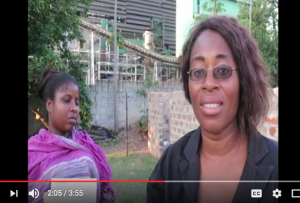 Standing in her garden with the smelter rumbling behind her East 1st Street resident Bridget Mbale told us how they have “lived with pollution” since 2006, and even had to run away from their homes during explosions and accidents, in one case only two days after she had a caesarean, and carrying her newborn baby. “We are nobody. We have no life.” She said, describing how they are routinely ignored when they complain to KCM management, and bemoaning the total lack of ‘social responsibility’ shown by KCM.
Standing in her garden with the smelter rumbling behind her East 1st Street resident Bridget Mbale told us how they have “lived with pollution” since 2006, and even had to run away from their homes during explosions and accidents, in one case only two days after she had a caesarean, and carrying her newborn baby. “We are nobody. We have no life.” She said, describing how they are routinely ignored when they complain to KCM management, and bemoaning the total lack of ‘social responsibility’ shown by KCM.
Watch Bridget’s 3 min testimony HERE.
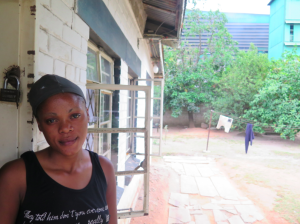
“When they built the smelter they never offered to relocate us. We didn’t even know what they were building.” says Lovelies Silweya. Yet Vedanta’s 2016 Sustainable Development Report claims that:
‘Our approach is based on the global principle of Free, Prior Informed Consent (FPIC), wherein disclosure of relevant project information, consultation and participation of all affected communities, and arriving at mutually acceptable solutions addressing matters of material concern to stakeholders, including affected communities, is done.’
In fact KCM had started construction on the smelter in February 2006, before they had even submitted an Environmental Impact Assessment (EIA), which they finally did on April 11th 2006. The EIA was approved by the Environmental Council of Zambia (ECZ) (now Zambia Environmental Management Authority – ZEMA) in July 2016 with multiple conditions, primarily that:
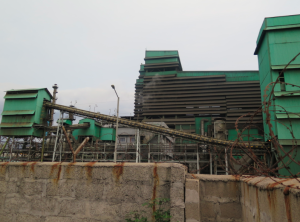
‘KCM shall develop a Resettlement Action Plan (RAP) and/or compensation package for people that may be affected by the project during the operation. This Resettlement Action Plan and/or compensation package shall be agreed upon between KCM and the residents that may be affected by the project and shall be submitted to ECZ for review and approval.’
Further, in the event that KCM fail to comply with this ‘the company shall relocate either the smelter plant or the affected residents to an appropriate area approved by ECZ.’ In addition ECZ would monitor stack and ambient air emissions, expecting reports from KCM on a ‘semi annual basis’.1
None of these conditions have ever been met and despite repeated complaint letters and meetings with KCM management no compensation or resettlement has been offered. In addition the ECZ (now ZEMA) has completely failed to follow up on the conditions they specified or investigate the condition of the communities who should have been consulted, and, with agreement, resettled at the inception of the project.
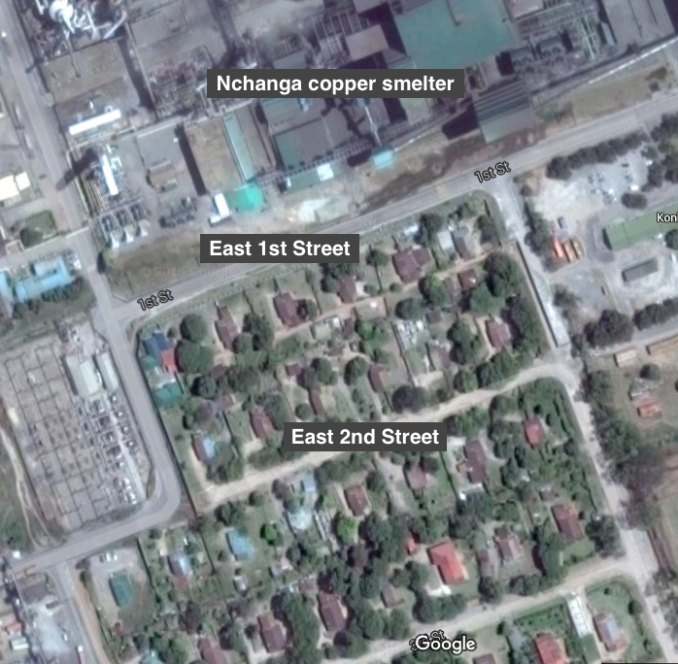
We are not lab rats!
“We’ve been disturbed with a lot of noise and pollution” says Freddy Muntete, a KCM employee, shouting over the noise of the smelter and visibly shaken as he shows us the metal sheets on the roof of his house, which have almost totally corroded only two years after he bought them due to acidic fumes.
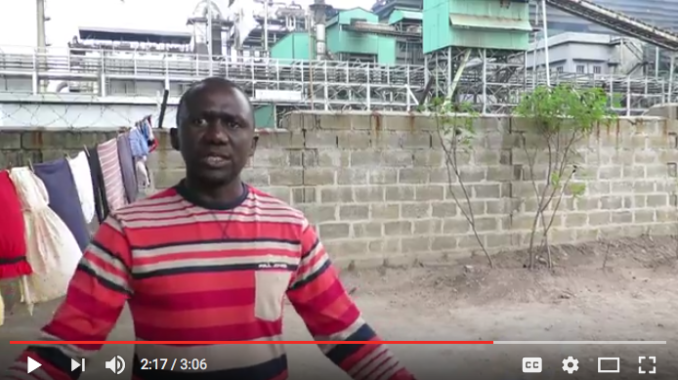
See Freddy’s testimony HERE.
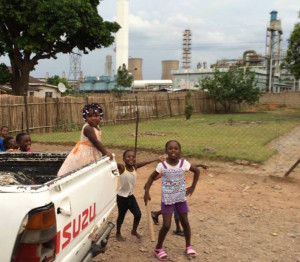
In the rainy season sulphuric emissions turn their gardens yellow, and many residents ask what the fumes are doing to their lungs if they can corrode metal roofing sheets within months. All of the residents complain of health problems – coughing, itching eyes and ears and bronchitis. Local children we met told us how they sometimes cough blood. The nursery school is just a few streets away from the plant, with the telltale rotten metal sheet roof.
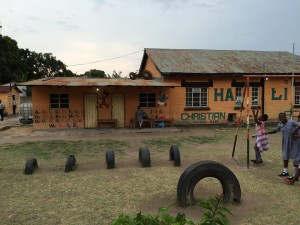
‘We are not lab rats!’ says local resident Ngmanaya Luhana posting on their recently formed facebook group Justice for Residents of 1st Street Against Pollution, where people have posted reports and photos of pollution and explosions which periodically occur at the plant, cracking the walls of their houses. In November 2015 Ngmanaya posted this protest along with a photograph of fumes from the plant:
We will fight until something is done about our living conditions enough is enough most us living just less than 50 metres from their Chingola plant its really a serious health hazard we do not even know how our health is now due to the toxic gases this plant is releasing in our atmosphere and neighbourhood its life threatening and inhuman, this company has no respect for our health as citizens as long as its making profits. personally am disgusted by their conduct concerning pollution, because as am writing this (23;33hours) the noise is above hundred (100dbs) decibels its very disturbing. TWANAKA NENU STOP KILLING US. GO BACK GO BACK .
Explosions and accidents
“In 2010 it started shaking and releasing smoke and fire and we had to run away. When the smelter is blasting our house shakes and the walls crack”, explains Lovelies Silweya.
Like Vedanta’s Tuticorin copper smelter, the Nchanga smelter already has a history of accidents and explosions occurring in the plant, which endanger both the workers, and the neighbouring communities. The East 1st Street residents recall major incidents in March 2009, 2010, 2013, 2nd July 2014 and 26th December 2015. Each time they heard explosions, felt vibrations which cracked their walls, and sometimes saw fire coming out of the plant as their streets were filled with smoke and fumes.
Only on one occasion after the 2014 incident did KCM management write to apologise to the community. After the Dec 26th 2015 explosion the plant remained closed for five days, yet there has been no penalty against KCM or concern shown for the residents by ZEMA or any other agency. Even Zambia’s ubiquitous NGOs have ignored the ticking time bomb at Nchanga South.
Health risks
KCM claim the smelter, designed by Finish firm Outotec captures 99.6% of sulphur emissions but the effect on the local vegetation and community suggests otherwise. Most importantly, there should be a considerable distance between the smelter and any residential area. In India the norm is 250m and in Europe considerably more.
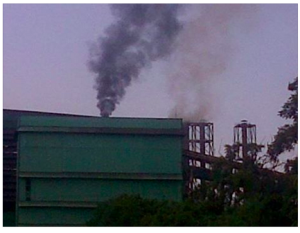
In May 2015 KCM imported 5000 tonnes of Chilean copper concentrates imported by containing up to 4% arsenic (compared to around 1% in Zambian copper). In June the Zambian government stopped further ‘toxic’ Chilean concentrates from bring imported after workers feared for their health when handling the material. According to the Zambian Post newspaper smelting these concentrates would result in high levels of Arsine gas, which is highly toxic and carcinogenic, being emitted. The government promised that remaining concentrates would be sent out of Zambia, but KCM employees told us that the toxic concentrates were being processed at night time despite these claims. What effect were the arsenic fumes having on East 1st and 2nd street and the rest of Nchanga South?
Air pollution has also been a major issue near KCM’s Nkana refinery in neighbouring town Kitwe. A 2012 academic study evidenced the damage done by sulphur dioxide pollution around the Nkana plant, which caused die-back in trees and killed vegetable gardens in the community, as well as affecting residents’ health2. In December 2013 KCM’s Nchanga smelter released so much sulphur dioxide that their PR head Joy Sata warned residents to stay in their homes. Though the incident was caused by a power failure at a government facility, KCM’s back up power source failed to kick in, causing the major leak at their plant. A similar leak at Vedanta’s Tuticorin smelter in Tamil Nadu in March 2013 led to a ‘bandh’ (shutdown) of the town by angry residents which saw most shops, taxis and businesses closed and thousands taking to the streets in protest. The plant was subsequently shut down for several months while authorities investigated multiple pollution issues.
A 2006 academic study of children living near a copper smelter in San Luis Potosi, Mexico, found high levels of lead and arsenic contamination in soil, leading to raised blood lead and urinary arsenic levels. 90% of children aged 3-6 years had blood lead concentrations above guidance limits.
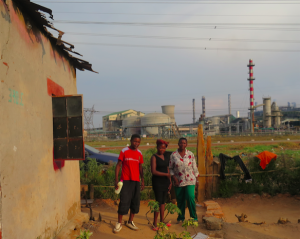
In nearby Mufilira, the appalling suffering of residents of Kankoyo township who live more than 200 metres downwind of Glencore subsidiary Mopani’s smelter, has been well documented. A 2012 report by CTPD notes that most crops except mango, avocado and cactus won’t grow in Kankoyo. The film Good Copper Bad Copper juxtaposes the enormous wealth of Glencore’s board and fraudster founder Marc Rich with the terrible conditions of Kankoyo residents. We visited Kankoyo and witnessed the badly corroded tin roofing sheets, which have to be replaced almost annually, and met teenage girl Chali Lumbwe who claimed that “you white people couldn’t survive more than a couple of days here” with the sulphur dioxide fumes that sting your eyes and throat.
Adding insult to injury after years of making windfall profits which were whisked out of the country into tax haven accounts, Mopani and KCM announced a combined 7000 job cuts in December 2015 citing commodity prices. The UK’s Daily Mail covered the double misery of Kankoyo residents facing both pollution and unemployment.
The residents must be resettled.
The suffering of East 1st Street residents is extremely shocking and painful to witness yet they have been ignored and marginalised for more than 10 years now. These communities deserve a serious apology from KCM, and their parent company Vedanta, as well as ZEMA and other Zambian authorities who have failed to represent them. Most importantly the whole area of 1st, 2nd and 3rd street must urgently be relocated to a suitable location, and compensated for the permanent damage to they and their children’s health. A full study of air emissions in Nchanga South should be carried out to assess the impact on other streets, parks and public spaces.
The children breathing these highly toxic fumes are Zambia’s future, yet their lives are being sold off cheap to foreign mining corporations like Vedanta and Glencore, who have been allowed to pollute without remorse while simultaneously stealing Zambia’s precious and finite mineral resource, using mis-invoicing, transfer pricing and tax havens to defraud Zambia’s exchequer. (This week a UN (UNCTAD) report confirmed our contentions on the scale of economic loss to Zambia caused by commodity mis-invoicing.) In addition Vedanta, Glencore and other companies are supported by Western governments through agencies like the Commonwealth Business Council – a UK government department which has promoted KCM repeatedly, and the Norwegian Government which owns 2% of Glencore. The theft of Zambia’s resources and the huge environmental, social and economic liabilities left behind must be understood as the neo-colonialism and environmental racism that they are.
1Edward Zulu, Director ECZ, letter to Chief Operating Officer of KCM on 6th July re: Proposed Nchanga mine new smelter complex by KCM in Chingola.
2Ncube, E., C. Banda, and J. Mundike, 2012, “Air pollution on the Copperbelt province of Zambia: Its sulphur dioxide